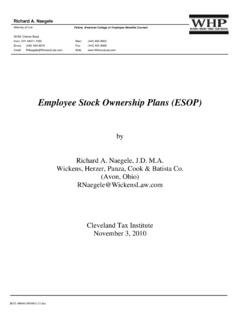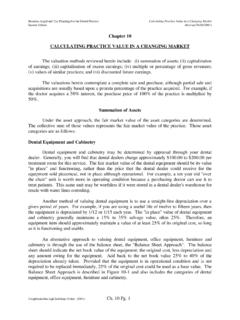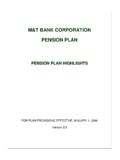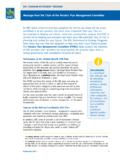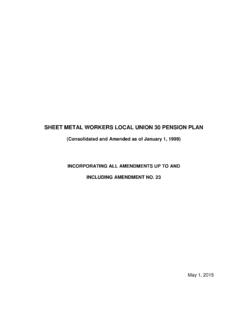Transcription of Multi-Employer Pension Plan Withdrawal Liability
1 \ Richard A. Naegele Attorney at Law Fellow, American College of Employee Benefits Counsel 35765 Chester Road Avon, OH 44011-1262 Main: (440) 695-8000 Direct: (440) 695-8074 Fax: (440) 695-8098 Email: RNaegele@W W eb: Multi-Employer Pension plan Withdrawal Liability by Richard A. Naegele, , Presented at: The Group Annual Meeting February 19 - 22, 2012 San Diego, California BOT Oscpa Seminar\ chapter 11 Multi-Employer Pension plan Withdrawal Liability Table of Contents I. OVERVIEW OF Withdrawal II. DETERMINATION OF WHETHER A Withdrawal HAS A. Complete Withdrawal . ERISA 4203(a).. B. Partial Withdrawal . ERISA C. Special Rules for Construction Industry. ERISA 4203(b).. D. Special Rules for Trucking Industry. ERISA 4203(d).
2 E. Definition of an Employer for Withdrawal Liability Purposes. ERISA 4001(b)(1).. F. Mass Withdrawal III. CALCULATION OF Withdrawal A. Methods for Computing Withdrawal Liability . ERISA B. Presumptive Method. ERISA 4211(b).. C. Reduction Under the de Minimis Rule. ERISA D. Partial Withdrawal . ERISA IV. PAYMENT OF Withdrawal A. Information to Be Furnished by Employer. ERISA 4219(a).. B. Notice and Collection of Withdrawal Liability by plan Sponsor. ERISA 4219(b)(1).. C. Payment Schedule Formula. ERISA 4219(c)(1)(C).. D. Length of Payments: Twenty-Year Payment Cap. ERISA 4219(c)(1)(B).. E. Commencement of Withdrawal Liability Payments. ERISA 4219(c)(2) and (3).. F. Prepayment of Withdrawal Liability . ERISA 4219(c)(4).. G. Default. ERISA 4219(c)(5).
3 H. Deductibility of Withdrawal Liability Payments. 404(g).. I. Refund of Withdrawal Liability Overpayments. ERISA 403(c)(2)(A)(ii).. V. RESOLUTION OF DISPUTES CONCERNING Withdrawal A. Request for Review of plan Sponsor s Determinations. ERISA 4219(b)(2).. B. Arbitration Proceeding. ERISA C. Payments During Arbitration Period. ERISA 4221(b)(1) and (d).. D. Preservation of Rights by VI. Liability FOR Withdrawal A. Common B. Personal C. Voluntary Assumption of Withdrawal Liability by Purchaser of Assets. ERISA D. Potential Liability of Purchaser of E. Employer Sale of Assets Limitation. 29 1405(a).. F. Employer Insolvency G. Statute of VII. THE Pension PROTECTION ACT OF 2006 ("PPA"): CHANGES TO Multi-Employer Pension A. PPA Modified the Funding Provisions of ERISA for Pension B.
4 Withdrawal Liability Model Letter Requesting Amount of Withdrawal 2011 by Richard A. Naegele Multi-Employer Pension plan Withdrawal Liability An earlier version of this chapter was published in the Journal of Pension Planning and Compliance (Spring 2011 by Aspen Publishers Inc.) BOT Oscpa Seminar\ chapter 11 Multi-Employer Pension plan Withdrawal Liability I. OVERVIEW OF Withdrawal Liability A. The Multi-Employer Pension plan Amendment Act of 1980 ("MPPAA") amended the Employee Retirement Income Security Act of 1974 ("ERISA"), to impose Liability for a share of the unfunded vested benefits of Multi-Employer defined benefit Pension plans on employers who withdraw from such plans. MPPAA was amended by the Pension Protection Act of 2006 ("PPA").
5 B. Under MPPAA when an employer withdraws from a Multi-Employer defined benefit Pension plan which has unfunded vested benefits, the employer is generally liable to the Pension plan for a share of the unfunded vested benefits in an amount determined under MPPAA. C. Questions to ask in a merger or acquisition: 1. Is there a collective bargaining agreement? 2. Does the employer contribute to a Pension plan on behalf of union employees? 3. Is the Pension plan a Multi-Employer plan or a single employer plan ? 4. If it is a Multi-Employer plan , is it a defined benefit plan or a defined contribution plan ? 5. If the plan is a Multi-Employer defined benefit plan , is it underfunded and is there a Withdrawal Liability ? 6. If there is a Withdrawal Liability : a.
6 A sale of assets may trigger Withdrawal Liability for the seller. b. A purchase of stock may result in an assumption of the potential Withdrawal Liability as a contingent Liability of the buyer. Pension and Profit-Sharing plan Overview and Update BOT Oscpa Seminar\ II. DETERMINATION OF WHETHER A Withdrawal HAS OCCURRED A. Complete Withdrawal . ERISA 4203(a). A complete Withdrawal from a Multi-Employer plan occurs when an employer: 1. Permanently ceases to have an obligation to contribute under the plan ; or 2. Permanently ceases all covered operations under the plan . The date of a complete Withdrawal is the date of the cessation of the obligation to contribute or the cessation of covered operations. B. Partial Withdrawal . ERISA 4205. A partial Withdrawal from a Multi-Employer plan occurs on the last day of a plan year in which there is either (1) a seventy percent decline in contribution base units; or (2) a partial cessation of the employer s contribution obligation.
7 1. Seventy percent contribution decline. A seventy percent decline in contribution base units occurs if, during the plan year and each of the preceding two plan years (the three-year testing period), the number of contribution base units (the units upon which contributions to the plan are based, such as hours worked or weeks worked ) for which the employer was required to make plan contributions did not exceed thirty percent of the number of contribution base units for the high base year. The high base year is determined by averaging the employer s contribution base units for the two plan years for which such units were the highest within the five plan years preceding the three year testing period. 2. Partial cessation of an employer s contribution obligation.
8 A partial cessation occurs in either of the following situations: a. A bargaining unit take-out. If an employer who is required to contribute to a plan under two or more collective bargaining agreements ceases to have an obligation to contribute under at least one but not all of the agreements, but continues work in the jurisdiction of the agreement of the type for which contributions were previously required or transfers such work to another location. b. A facility take-out. If an employer permanently ceases to have an obligation to contribute under the plan for work performed at one or more but fewer than all of its facilities covered under the plan , but continues to perform work at the facility of the type for which the obligation to contribute ceases.
9 Multi-Employer Pension plan Withdrawal Liability BOT Oscpa Seminar\ C. Special Rules for Construction Industry. ERISA 4203(b). The construction industry is afforded a partial exemption from the employer Withdrawal Liability rules. Generally, a construction industry employer will be permitted to withdraw from a plan without incurring any Liability , unless it continues to perform work in the covered area of the sort performed by the covered employees. The special rules apply to an employer contributing to a plan only if substantially all of the employees for whom the employer has an obligation to contribute perform work in the building and construction industry. In addition, the plan must (a) cover primarily employees in the building and construction industry; or (b) be amended to provide that the rules apply to employers with an obligation to contribute for work performed in the building and construction industry.
10 1. Complete Withdrawal . For plans and employers that qualify for the construction industry exception, a complete Withdrawal occurs only if the employer ceases to have an obligation to contribute to the plan , and, in addition, either (a) continues to perform the same or similar work ( , work of the type for which contributions were previously required) in the jurisdiction of the collective bargaining agreement; or (b) resumes such work within five years after the cessation of the obligation to contribute, and does not renew the obligation at the time of the resumption. 2. Partial Withdrawal . Under the construction industry exception, a partial Withdrawal occurs only if the employer s obligation to contribute under the plan is continued for no more than an insubstantial portion of the potentially covered work which the employer performs in the craft and area jurisdiction of the collective bargaining agreement.
